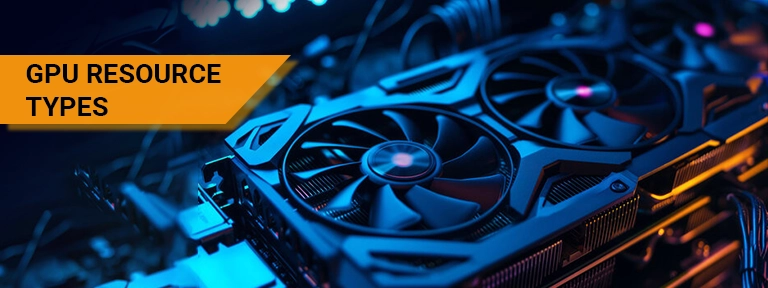Allocated GPUs vs. GPU Quota in RunAI: Differences Covered
At the time of handling GPU tasks in the case of RunAI, it is necessary to know about the key difference between GPU Quota and Allocated GPUs. Both of these terms directly impact how resources are generally requested, scheduled, and used across a variety of users and projects in the RunAI platform. This document covers the differences, how each one of them is utilized, and their connection in environments using GPU dedicated servers, GPU hosting, or enterprise-level GPUs such as NVIDIA A100 and NVIDIA A40.
Terminology
Allocated GPUs
Allocated GPUs basically refer to the number of GPUs that are presently in use by simply running tasks. This is an actual measurement of GPU usage.
- Allocated GPUs can be fractional if fractional GPU allocation is enabled (e.g., 0.5 GPU per job).
- This metric shows present utilization and can change dynamically as jobs start or stop.
- For instance, if any user submits a specific job that needs 2 GPUs and is scheduled effortlessly, then 2 GPUs are considered as “allocated.”
GPU Quota
GPU Quota refers to the highest number of GPUs a user or a project is allowed to use simultaneously. This limit is simply set by the cluster administrator to control and share resources productively.
- The quota guarantees fairness and blocks any one user or a whole team from dominating the cluster.
- For Instance: If any user has a GPU Quota of 8, they can easily run numerous jobs as long as the complete GPU allocation at any given time does not extend the limit of 8 GPUs.
Practical Differences
| Feature | GPU Quota | Allocated GPUs |
| Definition | A high number of GPUs a project or a user can utilize at a time | Real-time number of GPUs currently utilized |
| Set By | Administrator | Dynamic (as per running jobs) |
| Usage | Controls job submission limits | Shows real-time GPU utilization |
| Can Be Fractional? | Yes (if allowed) | Yes (if supported) |
| Limit GPU Scheduling? | Yes | No (utilized only for monitoring purposes) |
| Related To | Fair utilization policy and full access control | Performance metrics and resource monitoring |
Where This Employs in RunAI

When any user submits a specific job, the scheduler simply checks the GPU Quota of the project.
- If a sufficient amount of GPUs are available in the quota, the job is effortlessly scheduled, and those GPUs are considered as allocated.
- If not, then the job is in waiting until GPUs are released.
The dashboard and RunAI CLI display both metrics:
- GPU Quota: This shows the number of GPUs a project can still request.
- Allocated GPUs: Displays the number of GPUs currently being utilized by jobs.
Example Situations
- A project named “AI-Gen” has a total of 16 GPU Quotas.
- The team requests:
- 4 NVIDIA A100 GPUs for one AI image generator job.
- 6 NVIDIA A40 GPUs for two training jobs.
- Current utilization:
- Total Allocated GPUs = 4 (A100) + 6 (A40) = 10 GPUs
- Quota Remaining = 16 – 10 = 6 GPUs
If any other job is submitted needing 8 GPUs, it will not run until at least 2 GPUs are released or the quota is raised.
GPU Resource Types

At the time of utilizing RunAI along with GPU hosting or a GPU server, it is necessary to know about what type of hardware you are constantly working with. General GPUs are:
- NVIDIA A40
- Perfect for high-level inference and training tasks.
- 48GB GDDR6
- Appropriate for AI-based model development in the case of organizational environments.
- NVIDIA A100
- Enhanced for complex deep learning, scientific simulations, and high-performance computing (HPC).
- Easily available in both 40GB and 80GB models.
- Generally utilized for AI image generation, natural language processing (NLP), and foundation model training.
Both are FULLY compatible with fractional allocation in the case of RunAI (e.g., 0.25 A100 for a small-scale project), relying on how your infrastructure is set up.
Admin Set Up
GPU Quotas are set up by the cluster admin with the help of RunAI’s admin tools. Here’s an illustrative command to allocate a quota:
runai project set-quota ai-team –gpu 10
Checking Present Allocation for a user or project:
runai project get-usage ai-team
Both of these commands help admins to easily handle and check GPU access productively across teams utilizing shared GPU hosting assets.
Best Practices
- Utilize Quotas to Avoid Resource Monopolizing: Assign GPU quotas according to team or workload priority.
- Check Allocation vs. Quota Daily: Check utilization dashboards to prevent wasted or idle GPU capacity.
- Use Fractional GPUs: For general AI-based tasks or dev/testing, utilize fractional GPUs to enhance complete GPU usage.
- Match Tasks to GPU Type
- Utilize NVIDIA A40 for image generation or inference-heavy workloads.
- Utilize NVIDIA A100, especially for large-scale model training or running multiple tasks.
- Select the Appropriate Hosting Environment: For permanent use and high-performance demands, go for a GPU dedicated server. For scaling, GPU4HOST’s GPU hosting solutions are the best.
Key Takeaways
- GPU Quota is a non-changing limit on every project or user, which is set by admins.
- Assigned GPUs show real-time active utilization and vary dynamically.
- Both metrics are necessary for resource fairness, scheduling, and productivity in RunAI environments.
- Handling cutting-edge GPUs such as NVIDIA A100 and NVIDIA A40 productively needs a proper understanding of quota management.
- Proper utilization of quotas and monitoring can exceptionally enhance the usage of a GPU dedicated server and GPU hosting platforms.
Conclusion
Knowing about the difference between allocated GPUs and GPU quotas in RunAI is crucial for productive resource planning and task scheduling. Whereas GPU quota tells about the upper limit of GPUs on any project, allocated GPUs tell real-time utilization as per ongoing jobs.
Properly handling both guarantees full access to all resources, avoids bottlenecks, and helps the whole team to make the most out of innovative hardware from GPU4HOST such as the NVIDIA A100 and NVIDIA A40. Even if you’re working with a GPU dedicated server, cloud-based GPU hosting, or developing cutting-edge AI image generators, full visibility into GPU allocation and quota allows high performance and flexibility.
For enterprises running high-level AI-based tasks, RunAI’s GPU orchestration proficiencies combined with the appropriate hosting infrastructure form a robust foundation for modernization and productivity.


